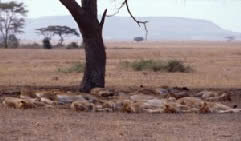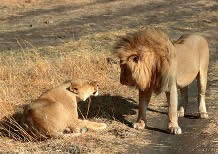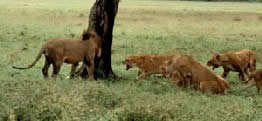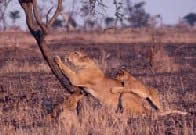|
Lioness and Cub Facts
|
Quick links to Lioness and Cub categories.
|

|
|
|
Lioness
Weight: 126 kg (277 lb) ; Height: 110 cm (44 in)
Male and female lions live in a large group named a pride with their cubs. With every pride we know that there are a king or kings of the pride, but where would the pride be without resident queens - the female lion - the lioness. The number of lionesses in a pride can be from two to twenty. This number can vary on the availibility of food in the territory. If food is scarse then some females will have to disperse and find another pride.

All females within a pride are usually but mostly related, e.g. sisters, aunts, neices etc. There is no rank hierachy among females and no two are likely to be found together more than half the time. All female residents know one another and when they meet, the lion greeting ceremony (rubbing and low purring) reaffirms their social ties. If a female shows no self assurance to meet and greet, this sends a signal that it doesn't belong in the pride and is treated as an intruder.
Lioness Hunting
Females are mainly the hunters of the pride, while males only hunt when a big kill is involved or the females have not given him a free lunch. The females usually hunt in a group (3 to 8 females) for there is a higher chance of the kill being successfull. One theory these sociable cats hunt together is to control exclusive hunting grounds and to share food with relatives. The females like to hunt in a broad front in an attempt to drive the quarry into an ambush or block the escape eoute of their prey, like wildebeests or zebras grazing alongside a river or woodland edge. When food is scarce, the females wont share the food that they are able to obtain with their cubs, so high cub mortality rates are high during times of prey scarcity. This might seem cruel but it stems from dire necssity.
Reproduction
The reproductive cycle begins when a female enters a period of sexual reception called "estrus". The females give off a scent from their reproductive organs and when a male sniffs and smells signs of oncoming estrus, they will follow the female until she is ready to mate.

Females may signal their interest in mating with elaborate tail movements and by "walking sensually past" a male and assuming a mating position. During mating males often bite the female at the nape of the neck and the act often ends with the female sarling with bared teeth at the male.
Females remain in estrus for approximately for four days and mating occurs several times an hour throughout the entire period. If females fail to conceive they will re-enter estrus approximately two weeks later and the cycle begins again.
Lioness and Cub
Females give birth 3.5 months after conception and give birth up to 4 cubs at a time although litters of 2 or 3 are more common. Often the first sign that a lioness has given birth are large stains around her nipples. Mothers of young cubs spend most of their time away from the pride, although they may join their companions for brief periods. Cubs are usually hidden in dense bush for approximately six weeks, when they are old enough to join the pride. During the six weeks the cubs rely entirely on their mother looking after them and feeding on their mothers milk.
Cubs begin eating meat at about the age of six weeks but continue to nurse until they are 6-7 months old and remain dependant on their mother for up to two years. Mothers in a pride often nurse each others offspring. This behaviour is actually less selfless than it appears, lions are most likely to nurse the offspring of their closest relatives, and they make an effort to deter cubs of more distant relatives as well as cubs that are older than their own.
If a litter is lost, females will return to estrus ( the reproductive cycle begins again) within as little as a week and can reproduce again but mothers whose cubs survive only begin to breed again after their cubs reach 18 months of age. Occasionally mothers will abandon their cubs if they are unable to provide for them. Mothers must remain in top condition in order to provide for their cubs and caring for cubs at their own expense would likely mean death for both.
Infanticide
Lion cubs are vulnerable to predators such as hyenas and leopards but the most significant threat comes from other lions. When a new male coalition takes over a pride they are often confronted by the cubs of the males that they defeated. Since females will not mate again until their cubs are 18 months of age, the new males kill all the young cubs in their new pride in order to bring the females back to estrus. Older cubs and sub adults stand a chance though because they are able to escape. These cubs are evicted and have to fend for themselves although occasionally their mothers will leave with them and remain apart from the pride until their cubs reach independence.

Females will often fight back when new males attempt to come and kill their cubs. Defending cubs against infanticidal acts by outside males is one of the primary reasons why female lions live in groups, as there is strength in numbers and only groups of females can often defeat infanticidal males and successfully protect their cubs. Although, this is only a short term solution to the problem of strange males.
In order to protect their young from wandering and invading lions and raise their young, females rely on protection from their resident males. Males keep invaders out of their territories by patrolling, marking and roaring, and they will also fight if they encounter a strange male within their territory.
Female lions are also infanticidal and will kill the young cubs of rival prides. However, they never kill the cubs of other females within their own pride. This differs lions from predators such as wild dogs where dominant females prevent their companions from breeding.
Play

Females remain playful when they are adults as males do not. Cubs play with anything that arouses their interest including ostrich eggs, turtles and their mothers tail. They sometimes try to play with adults but mostly play with each other. Most of their play imitates behaviors they will use as adults including stalking and fighting. Play is an important way for cubs to learn these adult skills as well as to form strong social bonds with their companions.
|


![]()